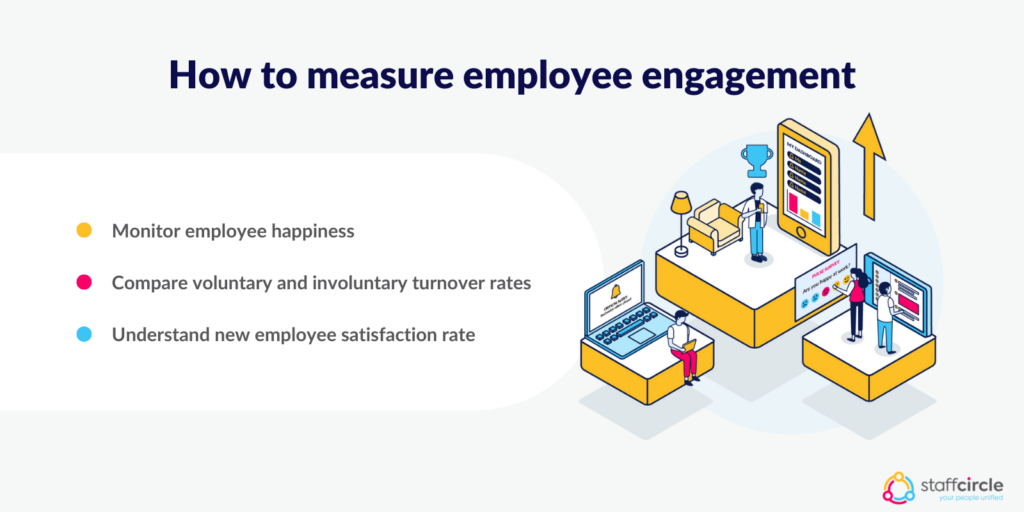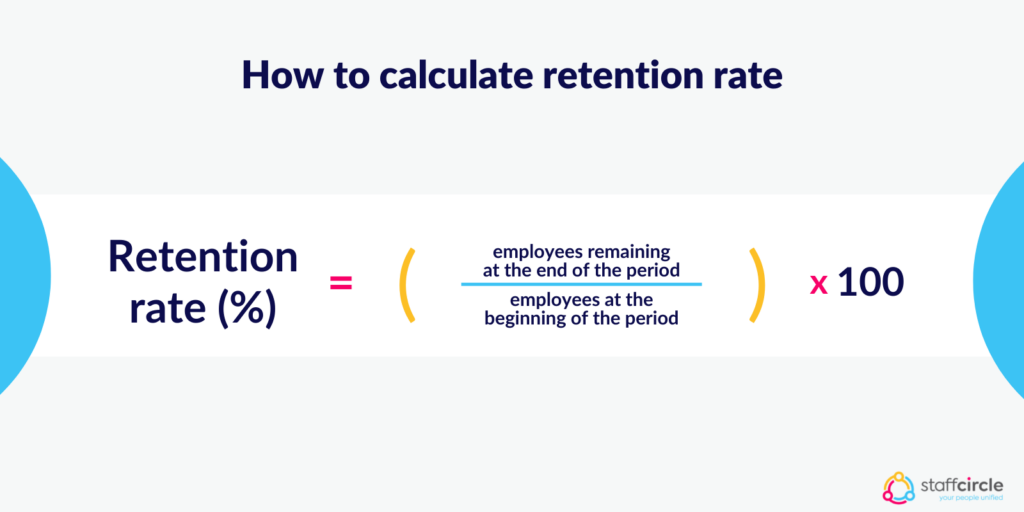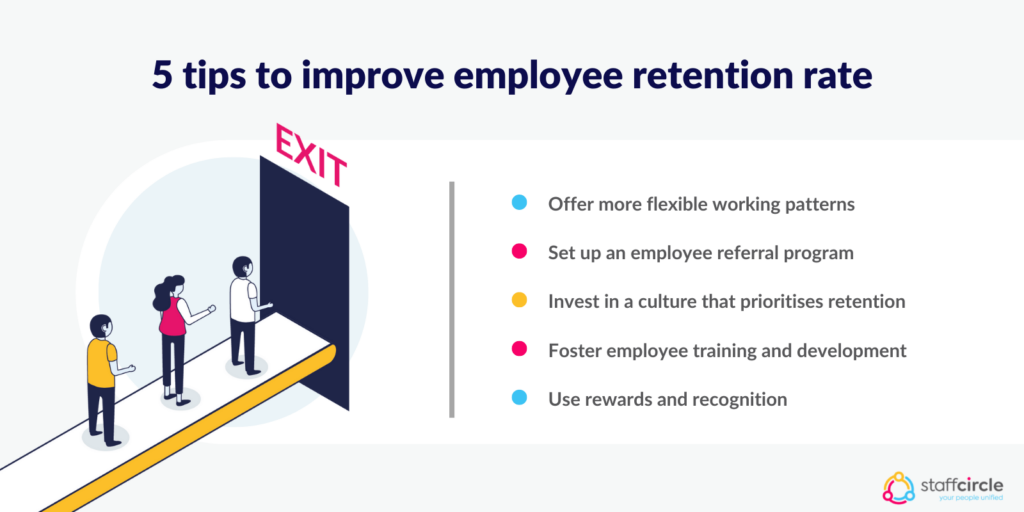As an increasing number of employees are choosing to move jobs, understanding your company’s employee retention rate is essential. When top talent leaves a company, overall engagement and performance can take a hit, along with the bottom line.
Read on to find out how to conduct an employee retention rate calculation and the measures you should take to ensure the right employees stay with your company.
What is the employee retention rate and why is it important?
Attracting and retaining the best talent is essential for organisational growth. As companies move from the Great Resignation to the Great Retention, maintaining a healthy retention rate is essential.
The employee retention rate is a simple way for business leaders to measure how successful they are at keeping the best employees. High turnover rates can often mean the company has failed to create a culture and workplace that keeps employees productive and engaged. In addition, failure to retain great employees adds extra costs for further recruitment, training, and development.
If there is a high level of voluntary turnover, the company must take steps to address the root causes of why employees are choosing to leave. This means drawing on a range of tools and analytics to better understand the driving forces and how to minimise their influence.

A report from Deloitte discusses how predictive analytics can play a role in reducing voluntary turnover. The report states:
“They conducted initial meetings with the client to develop a variety of diagnostic factors that would aid in predicting those employees who were likely to leave. The factors included obvious things like present and past work performance, span of control, level, benefits, and salary. Other, not so obvious factors, such as supervisor performance, were also included.”
With voluntary turnover costing up to $1 trillion annually for American businesses, it’s vital that companies conduct an employee retention rate calculation.
In this article, we’ll look at how you can use performance management tools to collect this and other relevant data. We’ll also touch on a range of other methods for improving retention rates and building a better people strategy, as well as some examples of how to calculate employee retention rates for your company.
Is it important to track employee retention rates?
The high cost of recruitment, onboarding, training and development is one reason why it is important to track employee retention rates. Tackling a poor retention rate helps your business to avoid these costs.
The advent of hybrid work is further complicating how companies address employee retention rates. The rise of hybrid working is driving talent retention with tech, forcing business leaders to rethink the employee experience. Measures that would be taken to address retention issues in the workplace are no longer applicable for employees working remotely.
These complications make tracking employee retention rates even more important. As talented employees seek new modes of work to satisfy the hybrid approach, the right tools are needed to gain insights. At the same time, the way culture is expressed and the methods of communication used are being reshaped to fit the changing business landscape.
What is a good employee retention rate?
Optimal turnover rates can vary depending on the industry or sector in question. Fast food outlets have a high turnover rate built into their business model, while other companies seek to invest in the future of their employees.
While turnover rates vary, a 90% employee retention rate is generally considered to be a healthy rate. Companies should therefore be aiming to get as close as possible to a 10% turnover rate.
According to data from the U.S Bureau of Labor Statics, the average annual turnover rate across all sectors was 57.3% in 2021. Voluntary turnover alone amounted to 25%, indicating that turnover rates are higher than they should be. There’s also the underlying suggestion that many businesses are lagging behind when it comes to addressing the key drivers of high turnover.
Clearly, there is room for improving HR processes and data collection, the workplace environment, and levels of engagement among employees. Next, we’ll examine some of the methods business leaders can adopt to achieve these results.
How can I increase employee retention rates?
Engagement is one of the key metrics to measure employee well-being and their likelihood of leaving or staying at a given company. A report from Gallup discussing the key drivers of retention explains the significance of having fully engaged employees:
“When employees are fully engaged — when they feel involved in, enthusiastic about and committed to their work — the percentage who would consider leaving for a raise of 20% or less drops to 37%, or by slightly more than 30% compared with actively disengaged workers.”

Working to optimise engagement is one way to help maintain a good employee retention rate. Some other measures to consider to improve employee retention rates include:
- Monitoring employee happiness. This can be achieved by using employee feedback mechanisms such as employee net promoter scores (eNPS) and other employee surveys that give insights into well-being and happiness.
- Comparing voluntary turnover rates with involuntary rates. While the former points to a poor employee experience, the latter suggests there may be a problem elsewhere. High rates of involuntary turnover could mean there’s a problem with the company’s recruitment practices.
- Understanding the satisfaction rate for new employees. By digging into the employee experience for new hires, business leaders can understand how effectively onboarding processes are at bringing them into the fold successfully.
Easy examples of employee retention rate calculation
Using an employee retention rate calculator is an easy way to view how well employees are being retained in a company.

Here’s the basic formula to effectively calculate the employee retention rate:
(Total number of employees at the start of a designated time period) – (the number of employees who left during the same time period) = (the number of employees who remain at the end of the time period)
The final value is then used as follows:
(Number of employees remaining at the end of the period) ÷ (total number of employees at the beginning of the period) = (percentage of retention)
Here are a couple of examples to illustrate how this formula looks when implemented:
A distribution company has 150 employees at the beginning of the designated period of time being assessed. At the end of this period, the number of employees was 120. Here’s the calculation:
150 – 25 = 125
125 ÷ 150 = 0.8333
The retention rate in this example is 83%.
Here’s a second example of this formula in action:
A factory has 230 employees at the beginning of the designated period of time being assessed. At the end of this period, the number of employees was 215. Here’s the calculation:
230 – 15 = 215
215 ÷ 230 – 0.93
The retention rate in this example is 93%.
5 Tips to Improve Employee Retention Rate
Once an employee retention rate calculation has been performed, business leaders and HR professionals can work to improve the rate moving forwards. Here are five tips to improve the employee retention rate
1. Offer more flexible working patterns
We’ve already touched on the trend towards increased hybrid working and how leading companies are adopting this approach to flexible work. Business leaders who are still trapped in the ‘9 to 5 office-based’ mentality may be experiencing higher turnover rates, as employees seek opportunities for flexible working elsewhere.
Offering flexible work can help to increase productivity and engagement, provided businesses make the necessary adjustments to how they communicate to employees. If the lack of hybrid working options is something that can be addressed, it may help improve employee retention rates.
2. Set up an employee referral program
Employee referral programs are an effective way to help ensure the best people for the roles are brought to a company. Existing employees are able to let these candidates know what to expect from their role, and how the company culture operates.
In addition to bringing people who are a better fit into the company, employee referral programs can help to save additional time and money on recruitment. Lengthy and expensive advertisement processes and other time-consuming aspects of recruitment are reduced to a minimum.

3. Invest in a company culture that prioritises retention
High turnover rates can sometimes be linked to a poorly defined company culture. Business leaders who invest in their company culture to improve retention help foster a happier and healthier workforce. Strong and clearly articulated values improve the motivation of members of staff by articulating a coherent vision of the future.
4. Foster employee training and career development
When employees feel unengaged with their work, with minimal opportunities to progress, their chances of leaving skyrocket. Fostering their career development and linking their personal and professional development within the company is crucial to avoid this sense of career stagnation.
This alignment of ambition with the company should begin the moment they start their first day at the company. A Personal Development Plan (PDP) can then be referred to throughout their journey within the organisation, keeping them on track to develop the skills needed for their career success.
5. Use rewards and recognition to demonstrate employees are valued
Employees who work hard need to know that they are valued by their bosses. When they feel as if their work isn’t appreciated, they’ll look for a new role elsewhere. Rewards and recognition programs should be integrated into a company’s daily habits.
This includes everything from training managers to show gratitude even for small wins to using performance management software to share rewards and accomplishments of individuals, teams, and departments.
Summary
With employee retention rates giving many companies cause for concern, it’s important that business leaders work closely with HR professionals to address them. This means putting in place the measuring tools to identify the attrition rate and adapt the company’s practices to maintain a productive employee experience.





